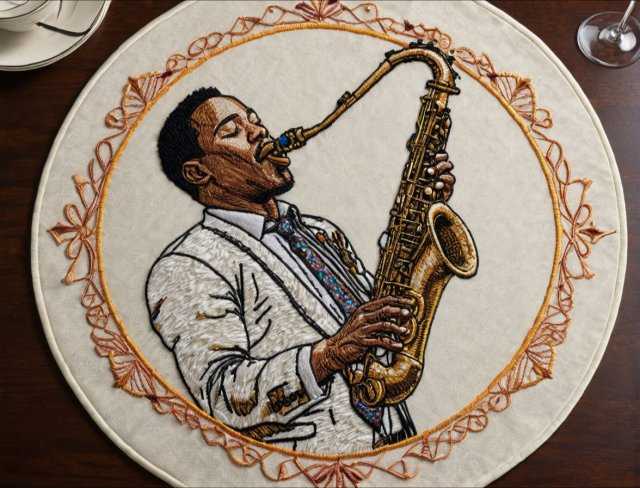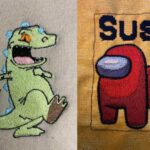Harmonize The Rhythm and Beat
An introduction to Music and Dance Embroidery
Introduction
Embroidery and dance, two distinct yet intricately intertwined forms of artistic expression, converge to create a vibrant tapestry of cultural heritage, rhythmic innovation, and creative imagination. As we embark on a journey through the captivating world of music and dance embroidery, we immerse ourselves in a rich symphony of rhythm, melody, movement, and thread. From the graceful movements of ballet to the infectious energy of hip-hop, each dance style inspires a unique array of embroidered motifs, reflecting the diverse rhythms and cultural traditions that define the global dance landscape.
Beyond the intricate stitches and vibrant designs lies a deeper narrative of cultural identity, artistic innovation, and human connection. Through the lens of embroidered artistry, we uncover the stories of generations past, the echoes of ancient traditions, and the vibrant pulse of contemporary creativity. Each embroidered motif serves as a testament to the enduring legacy of cultural heritage and the transformative power of artistic expression, bridging the gap between past and present, tradition and innovation. Join us as we delve into this multifaceted realm where music, dance, and embroidery intertwine, inviting us to explore, create, and celebrate the rhythmic tapestry of human experience.
Exploring the Melodic Tapestry
At the heart of music and dance embroidery lies a celebration of cultural heritage and artistic expression. Across diverse traditions and societies, embroidered motifs inspired by music and dance serve as visual symphonies, capturing the essence of rhythm and movement with every stitch. From the swirling patterns of folk dances to the intricate motifs of classical compositions, each design resonates with the soul-stirring melodies and dynamic rhythms that define musical and dance traditions worldwide.
Every embroidered motif tells a story, weaving together the threads of tradition, innovation, and personal narrative. Whether inspired by the lilting melodies of traditional folk songs or the pulsating rhythms of contemporary dance beats, each stitch carries with it the spirit of cultural identity and artistic interpretation. As we explore the melodic tapestry of embroidered artistry, we uncover the rich diversity of human experience, from the haunting strains of melancholy ballads to the joyous cadence of celebratory anthems.
In the intricate patterns of embroidery, we discover a visual language of symbolism and meaning, where every motif holds a story waiting to be told. The rhythmic interplay of colors, shapes, and textures evokes a sense of movement and dynamism, mirroring the fluidity and grace of dancers on stage. Through the art of embroidery, we embark on a sensory journey through the melodic landscapes of human emotion, traversing the highs and lows, the crescendos and decrescendos, of the human experience.
As we delve deeper into the melodic tapestry of music and dance embroidery, we are reminded of the universal power of artistic expression to transcend boundaries, unite communities, and ignite the imagination. Each embroidered motif serves as a testament to the transformative power of creativity, inviting us to listen, observe, and engage with the world around us in new and meaningful ways. Join us as we unravel the threads of tradition and innovation, melody and movement, in this captivating exploration of the melodic tapestry of embroidered artistry.
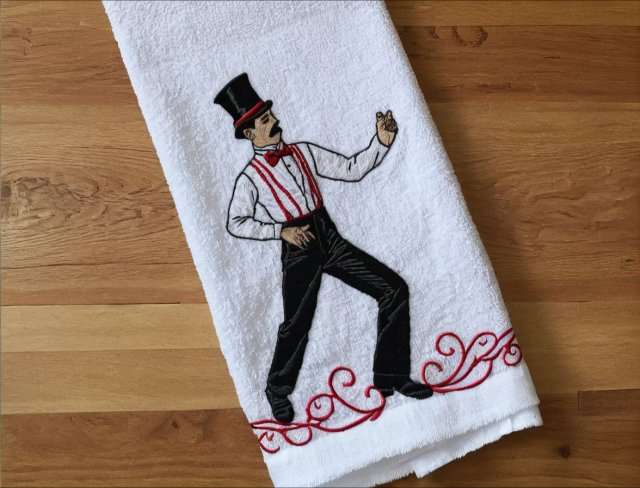
Symbolism and Significance
Within the intricate patterns of music and dance embroidery lies a rich tapestry of symbolism and meaning that transcends mere aesthetics. These embroidered motifs serve as more than just decorative embellishments; they encapsulate the essence of cultural identity, historical narratives, and profound emotions.
In many cultures around the world, specific motifs are imbued with symbolic significance, representing themes of joy, celebration, and unity. For instance, the rhythmic beats of drums and the graceful movements of dancers may be depicted through intricate patterns of stitches, symbolizing the interconnectedness of music, dance, and communal harmony. The drum, often considered the heartbeat of a community, symbolizes the pulse of life itself, while dancers embody the spirit of unity and collaboration through their synchronized movements.
Similarly, motifs inspired by musical instruments such as lyres, flutes, and tambourines evoke a sense of musical enchantment, inviting viewers to immerse themselves in the melodic magic of embroidered artistry. These instruments, steeped in cultural tradition and historical significance, serve as powerful symbols of creativity, expression, and human connection.
Music and dance embroidery offer a means of preserving and transmitting cultural heritage from one generation to the next. Through embroidered motifs that depict traditional dances, musical instruments, and rhythmic patterns, artisans pay homage to the rich tapestry of their cultural heritage, ensuring that these vibrant traditions endure for future generations to appreciate and celebrate.
In essence, symbolism and significance in music and dance embroidery go beyond mere ornamentation; they serve as a conduit for cultural expression, historical narrative, and emotional resonance. Each stitch tells a story, each motif carries a message, and each embroidered design serves as a testament to the enduring power of art to unite, inspire, and enrich the human experience.
Cultural Heritage and Artistic Innovation
Music and dance embroidery stand as a testament to the enduring legacy of cultural heritage and the dynamic forces of artistic innovation. Rooted in centuries-old traditions and cultural practices, embroidery serves as a tangible link to the past, preserving the stories, symbols, and aesthetics of bygone eras. Through meticulous craftsmanship and creative expression, artisans pay homage to the rich tapestry of their cultural heritage, infusing traditional motifs with contemporary flair and personal interpretation.
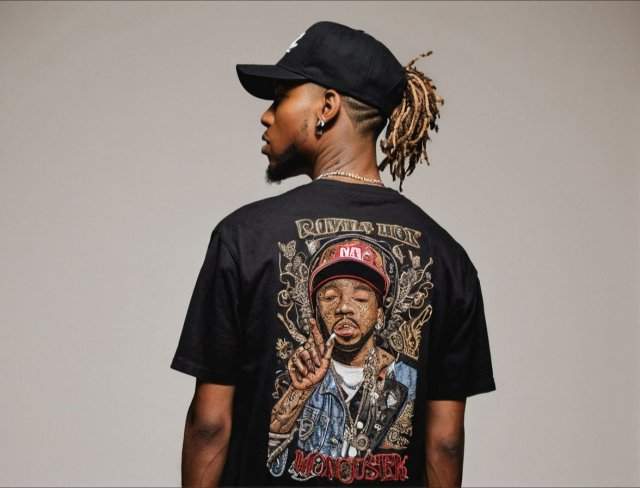
Embroidery serves as a medium for cultural exchange and cross-pollination, reflecting the interconnectedness of global artistic traditions. As artisans draw inspiration from diverse musical and dance styles, they engage in a dialogue that transcends geographic and cultural boundaries, enriching their own artistic practice while contributing to the broader tapestry of human creativity. This fusion of cultural influences and artistic innovation results in embroidered motifs that are both rooted in tradition and reflective of contemporary sensibilities, bridging the gap between past and present, tradition and innovation.
Music and dance embroidery offer a platform for marginalized voices and underrepresented communities to reclaim and celebrate their cultural heritage. By depicting traditional dances, musical instruments, and symbolic motifs in their embroidered designs, artisans assert their cultural identity and assert their presence in the broader artistic landscape. This act of cultural assertion and artistic expression serves as a form of resistance against cultural homogenization and colonization, reaffirming the value and significance of diverse cultural practices and artistic traditions.
Cultural heritage and artistic innovation in music and dance embroidery embody the dynamic interplay between tradition and creativity, heritage and innovation. Through their intricate designs and vibrant motifs, artisans weave together the threads of past and present, creating a tapestry of cultural expression that is as rich and diverse as the global communities from which it draws inspiration.
Elements of Music
Music, with its diverse array of sounds and rhythms, serves as a cornerstone of inspiration for embroidered artistry. Within the realm of music, various elements converge to create a harmonious tapestry of expression. From the pitch of a melody to the dynamic fluctuations of a crescendo, each element contributes to the rich and multifaceted landscape of musical composition. Let us explore the fundamental elements of music and their resonance within the realm of embroidered art.
• Pitch: Pitch refers to the perceived frequency of a sound, determining whether it is high or low in tone. In embroidery, motifs inspired by pitch may include:
♦ Violin: Known for its soaring melodies and expressive range, the violin evokes a sense of emotional depth and lyrical beauty.
♦ Flute: With its delicate timbre and fluid articulation, the flute embodies the ethereal quality of high pitched melodies.
• Beat: The beat provides the rhythmic foundation of music, dictating the pulse and tempo of a composition. Embroidered motifs inspired by beat may feature:
♦ Drum Set: Symbolizing the driving force behind rhythmic momentum, the drum set captures the dynamic energy of percussive beats.
♦ Tambourine: With its jingling rings and lively rhythm, the tambourine adds a playful and rhythmic element to embroidered designs.
• Timbre: Timbre refers to the unique quality or color of a sound, distinguishing one instrument or voice from another. Embroidered motifs inspired by timbre may depict:
♦ Piano: Renowned for its versatility and expressive timbral range, the piano offers a kaleidoscope of tonal colors and textures.
♦ Saxophone: With its warm and resonant timbre, the saxophone exudes a sense of soulful expression and melodic richness.
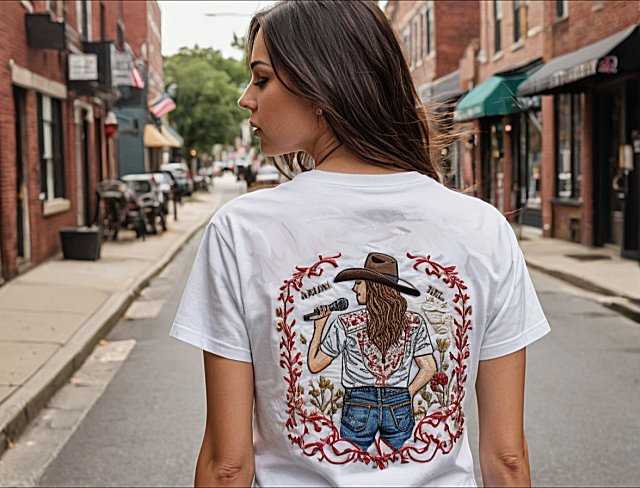
• Form: Form encompasses the structure and organization of musical composition, including elements such as repetition, contrast, and development. Embroidered motifs inspired by form may include:
♦ Guitar: With its rhythmic strumming patterns and melodic phrases, the guitar embodies the structural framework of musical form.
♦ Orchestra: Representing a symphonic ensemble of diverse instruments, the orchestra showcases the intricate interplay of musical themes and motifs.
• Dynamics: Dynamics refer to the variations in volume and intensity within a musical performance, ranging from soft and delicate to loud and powerful. Embroidered motifs inspired by dynamics may feature:
♦ Trumpet: With its bold and brassy sound, the trumpet commands attention and adds a vibrant dynamic contrast to embroidered designs.
♦ Harp: Known for its delicate arpeggios and expressive dynamics, the harp infuses embroidered motifs with a sense of grace and subtlety.
While exploring the elements of music within embroidered artistry, we encounter a tapestry of sonic inspiration and creative expression. While the motifs mentioned above offer a glimpse into the diverse world of musical embroidery, it is essential to acknowledge that countless other instruments and musical elements contribute to this rich and vibrant landscape. As we celebrate the intersection of music and embroidery, let us continue to draw inspiration from the boundless creativity and expressive potential of both art forms.
Rhythm and Groove of Dance
Dance, with its dynamic movements and rhythmic expressions, serves as a boundless wellspring of inspiration for embroidered artistry. From the fluid grace of ballet to the infectious energy of hip-hop, each dance style embodies a unique cultural heritage and artistic tradition. Let us explore the vibrant tapestry of dance styles and their influence on the world of embroidery.
• Ballet: Ballet, with its emphasis on poise, precision, and graceful movements, has captivated audiences for centuries. Embroidered motifs inspired by ballet may feature:
♦ Pointe Shoes: Symbolizing the ethereal beauty and technical prowess of classical ballet, pointe shoes evoke a sense of elegance and sophistication.
♦ Tutus: With their layers of tulle and delicate embellishments, tutus capture the enchanting allure of balletic costumes, reflecting the timeless charm of this beloved dance form.
• Hip-Hop: Hip-hop, with its infectious beats and urban flair, has emerged as a cultural phenomenon, influencing music, fashion, and dance worldwide. Embroidered motifs inspired by hip-hop may include:
♦ Boombox: A symbol of hip-hop culture and street dance, the boombox represents the rhythmic pulse and vibrant energy of urban music and movement.
♦ Graffiti Art: Reflecting the expressive aesthetic of hip-hop graffiti, embroidered designs may feature bold colors, dynamic shapes, and intricate patterns inspired by street art and urban culture.
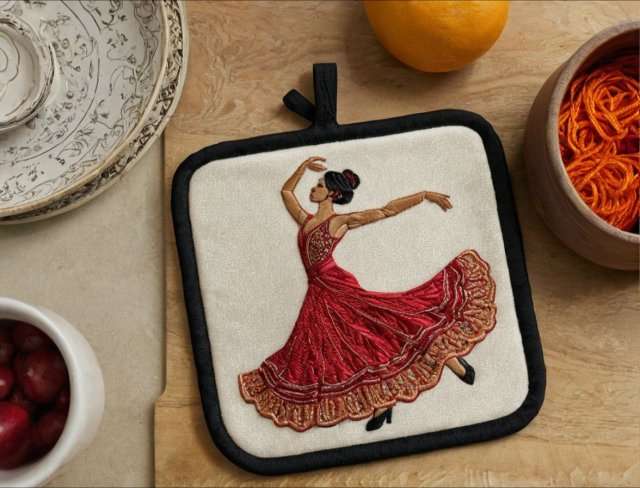
• Latin Dance: Latin dance, with its passionate rhythms and sensual movements, celebrates the rich cultural heritage of Latin America and the Caribbean. Embroidered motifs inspired by Latin dance may showcase:
♦ Salsa Dancers: With their intricate footwork and fiery spins, salsa dancers embody the vibrant spirit and infectious energy of Latin dance culture, capturing the essence of romance and rhythm.
♦ Flamenco Guitar: Symbolizing the soulful melodies and rhythmic intensity of flamenco music and dance, the flamenco guitar adds a touch of Spanish flair and dramatic flair to embroidered designs.
While perusing the diverse landscape of dance styles within embroidered artistry, we encounter a kaleidoscope of movement, rhythm, and cultural expression. While the dance styles mentioned above offer a glimpse into the rich tapestry of dance-inspired embroidery, it is essential to acknowledge that countless other dance styles and traditions contribute to this dynamic and ever-evolving art form. As we celebrate the rhythmic diversity and expressive potential of dance and embroidery, let us continue to draw inspiration from the boundless creativity and cultural richness of the dance world.
The fusion of dance and embroidery exemplifies the universal language of artistic expression and cultural celebration. From the graceful movements of ballet to the urban rhythms of hip-hop, each dance style inspires a unique tapestry of embroidered motifs, weaving together the threads of tradition, innovation, and creative imagination. As we embrace the rhythmic pulse and dynamic energy of dance-inspired embroidery, let us revel in the transformative power of art to unite, inspire, and uplift the human spirit.
The Artistic Process of Music and Dance Embroidery
Behind every exquisitely embroidered masterpiece lies a meticulous artistic process that marries skill, passion, and creative vision. This process begins with a spark of inspiration, often drawn from the rich tapestry of music and dance that surrounds us. From classical symphonies to urban beats, artisans immerse themselves in the rhythmic cadence and melodic motifs that define their chosen theme, allowing these elements to guide and inspire their creative journey.
Once inspired, artisans translate their vision into a tangible design, sketching out the intricate patterns and motifs that will adorn their embroidered canvas. This initial blueprint serves as a roadmap for the embroidery process, providing a framework for the placement of stitches, the selection of thread colors, and the overall composition of the design. With each stroke of the pen, artisans breathe life into their vision, infusing it with personal flair and artistic intuition.
With the design finalized, artisans embark on the meticulous process of stitching, employing a variety of techniques and methods to bring their vision to fruition. Whether working with traditional hand embroidery techniques or modern machine embroidery technology, artisans approach each stitch with precision and care, ensuring that every detail is executed to perfection. From delicate satin stitches to intricate French knots, each stitch contributes to the overall texture, depth, and beauty of the finished piece.
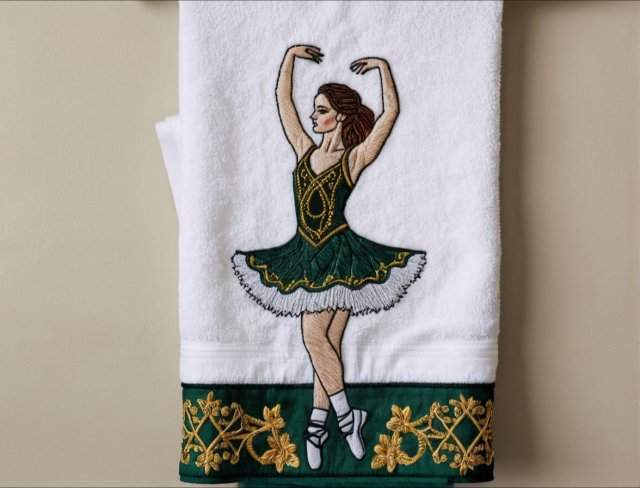
Throughout the embroidery process, artisans remain attuned to the rhythm and flow of their chosen theme, allowing the music and dance that inspired them to guide their artistic decisions. This symbiotic relationship between art and inspiration infuses each embroidered motif with a sense of vitality and dynamism, capturing the essence of movement, rhythm, and emotion in every stitch.
Unveiling the artistic process behind music and dance embroidery is akin to peeling back the layers of a richly woven tapestry, revealing the intricate craftsmanship and creative vision that lies beneath. It is a journey of exploration, discovery, and artistic expression, guided by the transformative power of music, dance, and the human imagination.
Celebrating Diversity and Inclusion
Music and dance embroidery serve as powerful catalysts for celebrating diversity and fostering inclusion within artistic communities worldwide. Embracing a multitude of cultural influences, these embroidered motifs become vibrant expressions of the rich tapestry of human experience, transcending geographic and cultural boundaries to unite individuals from all walks of life.
At its core, music and dance embroidery celebrate the diversity of global artistic traditions, offering a platform for marginalized voices and underrepresented communities to reclaim and celebrate their cultural heritage. By depicting a wide range of musical and dance styles, artisans affirm the value and significance of diverse cultural practices, challenging prevailing narratives of cultural hegemony and promoting a more inclusive understanding of artistic expression.
Music and dance embroidery serve as a vehicle for cross-cultural exchange and dialogue, fostering connections and understanding across diverse communities and traditions. Through the universal language of art, embroidered motifs transcend linguistic barriers, inviting viewers to explore and appreciate the rich diversity of global musical and dance heritage. This exchange of ideas and perspectives enriches the artistic landscape, promoting mutual respect, empathy, and collaboration among artists and audiences alike.
Furthermore, music and dance embroidery offer a means of amplifying marginalized voices and advocating for social justice and equality. By depicting themes of resistance, resilience, and cultural pride in their embroidered designs, artisans shed light on issues of social injustice and systemic inequality, sparking conversations and inspiring action within their communities. Through their creative expression, artisans assert their agency and assert their presence in the broader artistic landscape, contributing to a more inclusive and equitable world.
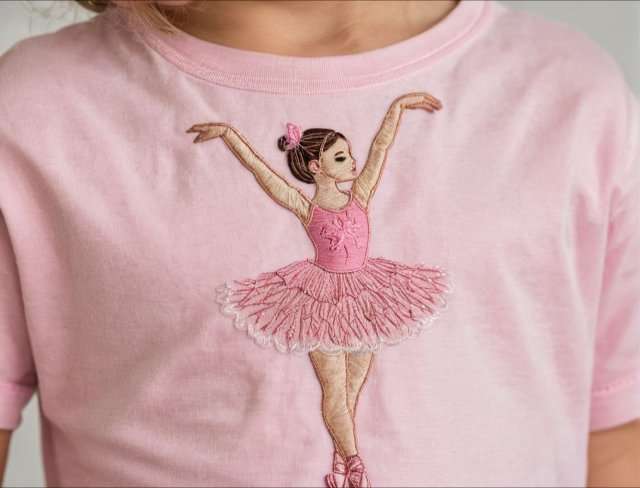
Celebrating diversity and inclusion in music and dance embroidery is not merely an act of artistic expression but a powerful statement of solidarity and support for marginalized communities worldwide. By embracing the rich tapestry of global artistic traditions and promoting cross-cultural exchange and dialogue, embroidered motifs become symbols of unity, resilience, and hope, paving the way for a more inclusive and equitable future for all.
Conclusion
In conclusion, music and dance embroidery serve as powerful conduits for artistic expression, cultural celebration, and human connection. From the intricate motifs inspired by the rhythmic cadence of dance to the vibrant designs influenced by the melodic magic of music, each embroidered masterpiece encapsulates the rich tapestry of human experience. Through their creative vision and meticulous craftsmanship, artisans weave together the threads of tradition and innovation, heritage and creativity, inviting us to explore, celebrate, and cherish the diverse rhythms and cultural traditions that define our world.
As we immerse ourselves in the captivating world of music and dance embroidery, let us embrace the harmonious interplay between melody, movement, and the transformative power of embroidered artistry. Let us recognize the profound meanings, symbolic significance, and cultural heritage woven into each intricately stitched design, and let us celebrate the diversity and inclusivity that these embroidered motifs represent. Ultimately, music and dance embroidery serve as a testament to the enduring power of art to unite, inspire, and uplift the human spirit, offering a glimpse into the boundless creativity and cultural richness of the global community.
Now that you have read through this article, feel free to SHOP for products we have created. If you are looking for something special which isn’t in our store, feel free to contact us.

